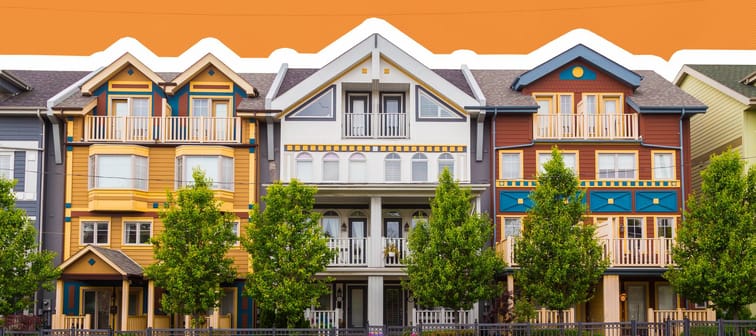Current 10-year mortgage rates
The current average 10-year fixed mortgage rate APR ranges from around 6.36% to 6.43%.
Invest in real estate without the headache of being a landlord
Imagine owning a portfolio of thousands of well-managed single family rentals or a collection of cutting-edge industrial warehouses. You can now gain access to a $1B portfolio of income-producing real estate assets designed to deliver long-term growth from the comforts of your couch.
The best part? You don’t have to be a millionaire and can start investing in minutes.
Learn MoreHow does a 10-year mortgage work?
A 10-year mortgage is one that has an amortization period — or time to repay the loan — of only 10 years, while most traditional mortgages have an amortization period of 30 years.
The shorter amortization period means that your mortgage will cost you more on a monthly basis, but more of the money that you pay will go to the principal of your loan, and not the interest.
If you purchase a home for $375,000, a 20% downpayment would be $75,000. This will mean you require a mortgage for $300,000 — the principal of your loan. Based on the average 30-year fixed-rate mortgage of 6.18%, your monthly payment would be approximately $1,818. For a 10-year fixed rate mortgage at 5.66%, your monthly payments would be approximately $3,270.
For the 30-year fixed-rate mortgage, that means that for the first 10 years, you would be paying about $170,056 in interest alone. Over the lifetime of the loan, that amount paid in interest would more than double to around $354,879. For a 10-year fixed-rate mortgage, the amount of interest you pay would total about $92,380 for the entire term.
Pros and cons of a 10-year mortgage
Pros
- You’ll own your home faster.
- It typically has a lower annual percentage rate (yearly interest) than longer mortgages.
- You’ll pay less in interest.
Cons
- You have higher monthly fees.
- It is more difficult to qualify for.
- You’ll have less purchasing power.
Need cash? Tap into your home equity
As home prices have increased, the average homeowner is sitting on a record amount of home equity. Savvy homeowners are tapping into their equity to consolidate debt, pay for home improvements, or tackle unexpected expenses. Rocket Mortgage, the nation's largest mortgage lender, offers competitive rates and expert guidance.
Get StartedWhat's the difference between the interest rate and APR?
When looking at mortgage rates, it’s important to consider the difference between interest rate and the annual percentage rate (APR).
Interest rate refers to the cost to borrow money for your mortgage. It’s represented as a percentage, and solely reflects the cost you have to pay each year for borrowing the money.
The APR is a more accurate measure of how much you will have to pay each year for your mortgage, as it includes the interest rate as well as any fees associated with borrowing the money, like broker fees.
What is a fixed-rate mortgage?
A fixed-rate mortgage is one that’s interest rate doesn’t change over the term of your loan.
Because fixed-rate mortgages offer stability in the amount you pay month-to-month, they are a safe bet when it comes to purchasing a home. Your budget will remain consistent over the term of your mortgage, so you can safely budget what your costs will be.
Typically, the longer the term of your loan, the higher the interest rate. If you have a 30-year fixed-rate mortgage, the amount you pay in interest per month will be a greater percent than if you have a 10-year fixed rate mortgage.
No matter the fixed-rate mortgage you’re applying for, you’ll want to ensure you’ve got a good credit score - usually one of 620 or above is required.
What is an adjustable-rate mortgage (ARM)?
An adjustable-rate mortgage is one that the interest rate varies. The higher the general interest rate, the higher the rate on your ARM will be and vice-versa.
ARMs are more risky than fixed-rate mortgages since the rate can rise and your monthly payments can fluctuate. For instance, with the latest rate-hikes, you could have seen your ARM rise significantly, making mortgage payments more difficult.
At the same time, ARMs often offer lower interest rates than fixed-rate mortgages due to their increased volatility. Additionally, if interest rates drop, you benefit from paying more to your principal on a monthly basis.
If your ARM has a cap — which is a percentage that it will not increase more than on a monthly or yearly basis — you run the risk of encountering negative amortization. This occurs when payments on your mortgage are less than your interest costs.
Caps can carry over year-to-year, so it’s possible that if interest rates increase one year, then decrease the next, you will still face higher rates due to the carry over.
ARMs come in different varieties, for instance a 10/1 ARM mortgage or a one-year ARM mortgage. A 10/1 ARM mortgage indicates that your interest rate will be fixed for 10 years, then adjusted every year after that. You might also encounter 7/1 or 5/1 ARM mortgages.
A one-year ARM mortgage has a fixed rate for one year, then adjusts after that up to any cap.
Are 10-year mortgage rates tied to the 10-year Treasury?
On face value, it doesn’t seem like a 10-year Treasury note and a 10-year mortgage rate have a lot in common, besides sharing a time period. But the two are in fact linked.
The 10-year Treasury note is seen as a standard that other interest rates, like mortgage interest rates, are held up to.
Investors who purchase a Treasury note for a period of 10 years, are buying a relatively safe form of debt issued by the U.S. government. While the bond is set to mature 10 years after it is issued, holders are paid a fixed amount of interest every six months.
Investors are always looking for the best return on investment. When the Treasury yield increases, buyers of other fixed-income investments look for a higher return on their riskier investments.
Mortgage-backed securities (securities that are based on the value of a home loan) are higher risk — meaning there is a greater chance of individuals not being able to pay them off. As a result, investors expect a higher rate of return to compensate for risk they are taking. This in turn results in higher interest rates on new 10-year mortgages.
Mortgage rates will rise as the interest rates on 10-year treasury rise to provide a balance in the market. The treasury yield only affects fixed-rate mortgages.
Refinancing your mortgage
Refinancing your mortgage is when you renegotiate your existing loan. By refinancing your mortgage, you can get a longer- or shorter-term mortgage, which can help you by either giving you a lower monthly payment or letting you pay off your loan faster.
Some other reasons to consider refinancing your mortgage are to access the equity you have in your home for things like renovations, or to consolidate your debts.
Essentially, by refinancing your loan you are paying off your existing mortgage with a new one.
When you refinance your mortgage, you should be aware that you may have to pay additional fees, like prepayment charges and closing costs.
Before you refinance your loan, speak to your lender and get a clear understanding of the implications.
Can I refinance into a 10-year mortgage rate?
If you are currently in a long-term mortgage, it is possible to refinance into a 10-year mortgage. You could consider refinancing to this type of mortgage if:
You are looking to lower your interest rate: switching to a 10-year mortgage will have you paying less money in interest and more toward the principal of your home.
You want to shorten your term length: if you have the capital and can afford the higher monthly fee, you could refinance a 30-year mortgage into a 10-year fixed-rate one after the first 10 years, reducing your remaining term by half.
You want to switch the type of interest you pay: it is possible to change from a fixed-rate mortgage to an adjustable-rate and vice-versa.
Be aware that refinancing your mortgage has additional costs. You will have to pay closing costs of around 2% to 5% of your remaining principal balance, as well as additional administration fees.
Is a 10-year fixed-rate mortgage a good idea right now?
If you are purchasing a home, and have the money available to pay the higher monthly fees, a 10-year fixed-rate mortgage could be right for you. You’ll be able to pay off your mortgage quickly and therefore spend less money on interest.
Ten-year mortgages are more difficult to qualify for since the lender wants to ensure you’re able to handle the higher monthly fees. These mortgages are also not as common as some other mortgage types, so you may have to search more to find a lender that provides it.
If you’re refinancing your mortgage, a 10-year fixed-rate mortgage can be a great option.
While your monthly payments will be higher, you will get greater savings in the long-term due to paying less money in interest. It should be noted that the amount of interest you pay for a 10-year fixed-rate refinance will be slightly higher than that of a new 10-year fixed-rate mortgage.
How to get the best 10-year fixed rate
When you’re looking for the best 10-year fixed-rate mortgage, consider if it’s the right type of mortgage for you. Can you afford the higher monthly fees? Is your debt-to-income ratio strong enough to support the loan?
After you’ve looked at your finances, here are some steps to ensure you get the best 10-year fixed-rate mortgage.
Comparison shop
If you have a mortgage, speak to your provider to find out if they offer a 10-year option. See what interest rate they'll offer you, and if they’ll waive any fees due to you being an existing customer.
Even if your provider does offer a 10-year mortgage, take time to speak to a variety of lenders to find out what they offer. Compare their interest rates, and take a look at the terms of the mortgages.
If you prefer, speak to a mortgage broker who will take the leg work out of your search. While you will pay a fee to the broker, they can often get you the best rate on a mortgage, so the price you pay in fees is made up for.
Improve your credit score
One of the first things lenders look at when determining the mortgage you’re eligible for is your credit score.
Typically, a credit score of 620 or higher is required to get a conventional mortgage. But the higher your credit score, the better chances of approval you have. You might also get a cheaper interest rate.
Some ways you can improve your credit score are:
Keep your credit card balance low: Pay off your credit card every month with no carry over. Keep your purchases within 30% of your credit limit, or even better, pre-pay your credit card so any purchases you make are automatically accounted for in cash.
Ensure your bills are paid: From electricity to taxes, make sure your bills are paid on time. This is potentially the number one factor in determining credit score.
Get your credit report in advance: contact Equifax, Transunion and Experian for a copy of your report. Check it over to ensure that there are no errors. If something’s off, report it and get it straightened out.
Be aware that some lenders use your FICO score (Fair Isaac Corporation) to determine your eligibility. This score is based on all your credit reports, so it’s worth checking each individually to ensure no errors.
Use your credit card: But be sure to pay it off. This increases the credit available to you, and can help increase your credit score.
If you have multiple credit cards, be sure that they’re all paid off and you have no carry over in debt. You want to have as clean a record as possible — but you still want to have a credit record of some kind.
Increase your down payment
A higher down-payment means that you’ll have to borrow less money for your mortgage. This means that your monthly payments are less,and can make a 10-year fixed-rate mortgage easier to handle.
Remember, if you make a downpayment of less than 20%, not only will you have a higher mortgage to pay off over time, but you’ll also need to pay mortgage insurance.
Find the Best Mortgage Rates to Fit Your Budget
Looking for a great mortgage rate? Don’t overpay on your home loan! Get updated mortgage rates, expert insights, and tips to lock in the best deal tailored to your needs. Save on monthly payments and make homeownership more affordable. Start your journey to savings now.









